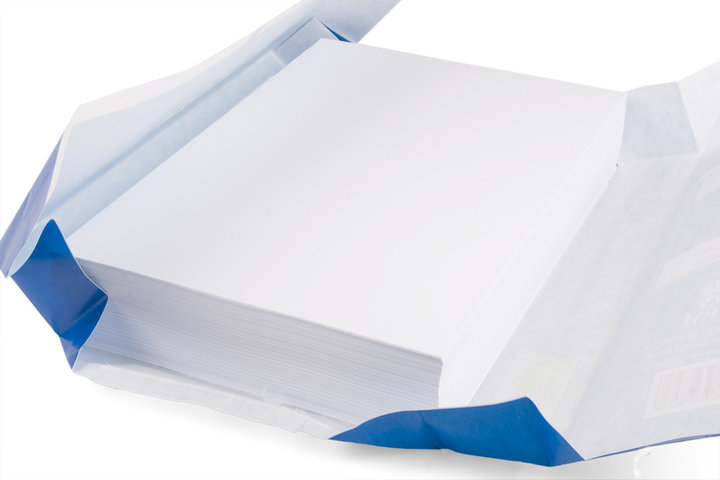
Ever wondered why some paper feels thicker but weighs less? Paper weight is more than just thickness—it affects print quality, durability, and cost.
Understanding how paper weight is measured is essential for choosing the right type for your project. Different measurement systems, like pounds (lb), grams per square meter (GSM), and points (pt), make comparisons tricky.
In this post, you’ll learn how paper weight is calculated, the differences between measurement systems, and how to choose the best paper for your needs.
What Is Paper Weight?
Understanding paper weight is crucial for selecting the right material for printing, packaging, and design projects. Many assume that paper weight refers only to thickness, but it's actually determined by multiple factors, including basis weight, density, and composition.
Definition of Paper Weight
Paper weight is a measure of how much a specific quantity of paper weighs. It is typically determined by:
Basis weight (lb): The weight of 500 sheets (a ream) of uncut paper in a specific standard size.
Grams per Square Meter (GSM): The weight of one square meter of paper, regardless of sheet size.
Points (pt): A measurement of thickness, where 1 point equals 1/1000th of an inch.
Common Misconceptions About Paper Weight
1. Paper Weight Equals Thickness (❌ False!)
A heavier paper does not always mean it is thicker.
Coated papers, like glossy brochures, may be thinner than uncoated papers of the same weight.
2. Two Papers with the Same Weight Feel Different
3. Different Paper Types Use Different Basis Weights
Key Takeaways
✅ Paper weight is determined by more than just thickness.
✅ Different paper types use different measurement standards.
✅ Density and composition influence how paper feels and performs in printing.
How Is Paper Weight Measured?
Paper weight is measured using different systems depending on region and application. The four most common methods include Pounds (lb), Grams Per Square Meter (GSM), Points (pt), and Caliper Thickness Measurement. Each method serves a unique purpose, making it essential to understand how they work to choose the right paper for your needs.
1. Pounds (lb) – The U.S. Standard
The pounds (lb) system, also known as basis weight, is primarily used in the United States. It measures how much 500 sheets (a ream) of uncut paper weigh. However, because different types of paper have different standard sheet sizes, a 100 lb text paper is not the same as 100 lb cover stock.

How It Works:
Basis weight = Weight of 500 uncut sheets of a specific type of paper
Each paper type has a unique basis size (e.g., bond paper: 22" x 17", cover paper: 20" x 26").
This is why the same weight in pounds can feel different depending on the paper type.
Common Paper Weights in Pounds
| Paper Type | Common Weights (lb) | Uses |
| Bond Paper | 20 lb, 24 lb, 32 lb | Office printing, documents |
| Text Paper | 50 lb, 70 lb, 100 lb | Brochures, magazines, flyers |
| Cover Paper | 60 lb, 80 lb, 130 lb | Business cards, book covers |
2. Grams Per Square Meter (GSM) – The Global Standard
The GSM system is the most widely used measurement internationally because it provides a direct weight comparison across different paper types. GSM measures how many grams a single square meter (1m²) of paper weighs, regardless of sheet size.
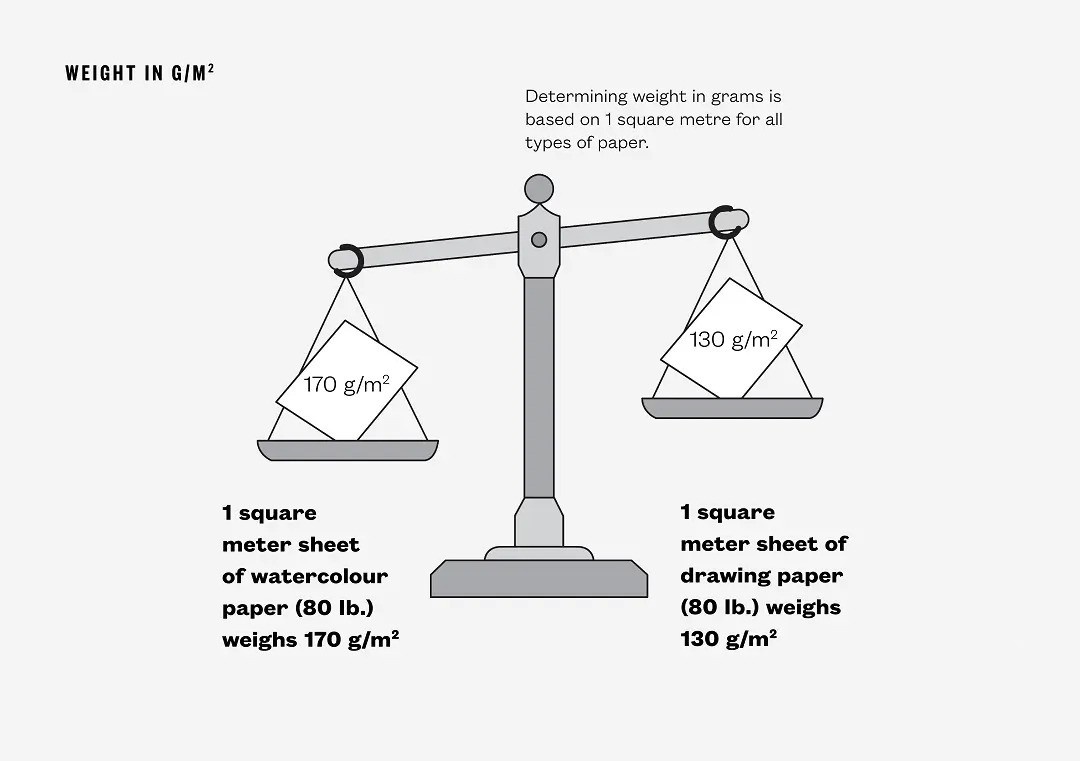
Why GSM is Useful:
Common Paper Weights in GSM
| GSM | Paper Type | Uses |
| 75-90 | Standard printer paper | Office printing, notebooks |
| 100-170 | Text weight paper | Magazines, flyers, brochures |
| 200-350 | Cover stock | Postcards, business cards, packaging |
How GSM is Determined:
A 1m² sheet of paper is weighed in grams.
Example: A 1m² sheet that weighs 150 grams is labeled as 150 GSM.
The higher the GSM, the thicker and heavier the paper.
3. Points (pt) – Thickness Measurement
The points system (pt) measures paper thickness rather than weight. It is primarily used for card stock, packaging, and premium print materials. One point equals 1/1000th of an inch.
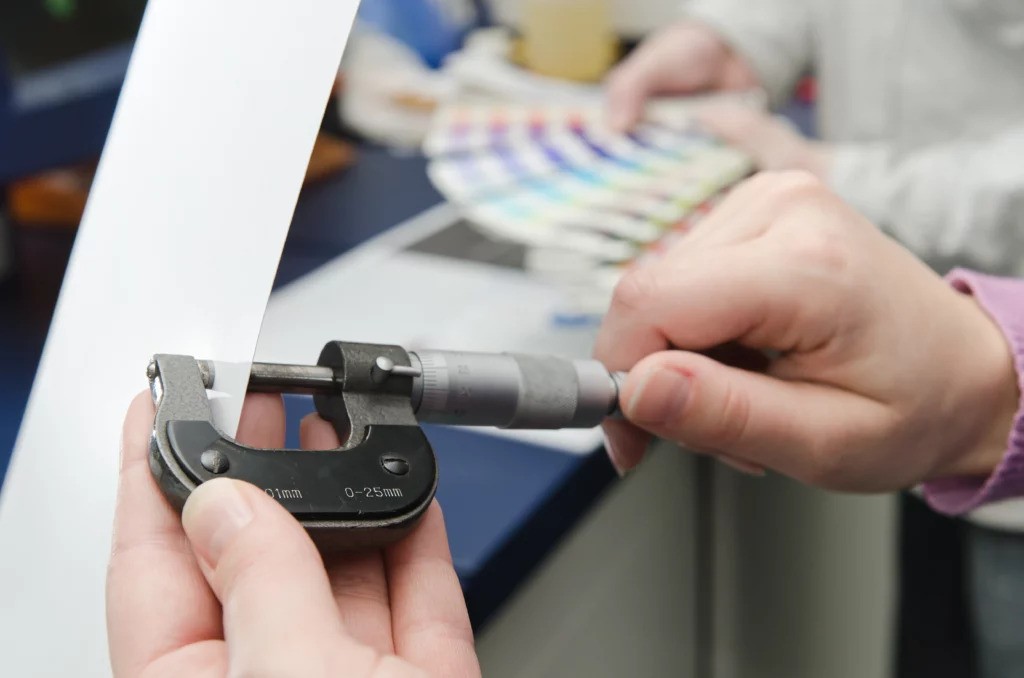
Why Points Matter:
Best for stiff paper types like business cards and postcards.
More relevant than weight for certain projects, such as invitations and covers.
Standard thickness values: 10 pt (~0.01 inches), 14 pt, 16 pt, etc.
Common Paper Thickness in Points
| Points (pt) | Equivalent GSM | Common Uses |
| 10 pt | ~230 GSM | Brochures, postcards |
| 14 pt | ~310 GSM | Business cards, invitations |
| 16 pt | ~350 GSM | Premium packaging, covers |
When to Use Points Instead of Weight:
When stiffness and durability are more important than actual weight.
For materials like greeting cards, packaging, and thick brochures.
Caliper Thickness Measurement
Caliper thickness is the precise measurement of paper thickness using calipers. This is important for printing, mailing, and ensuring compatibility with machinery.
How Caliper Measurement Works:
Measures paper thickness in thousandths of an inch (mil).
Helps in determining if a paper is too thin for automated mailing machines.
Used by printers to adjust press settings for optimal print quality.
Caliper Thickness and Mailing Requirements
| Thickness (inches) | Use Case |
| 0.007" (7 pt) | Minimum for US postal mailing |
| 0.009" (9 pt) | Ideal for postcards |
| 0.016" (16 pt) | Premium business cards, packaging |
Why Caliper Thickness Matters:
Ensures paper meets mailing regulations (e.g., USPS requires 0.007" minimum).
Helps prevent misfeeds in printing machines.
Affects print quality and durability in commercial printing.
Paper Weight Conversion: Understanding the Differences
Paper weight can be confusing, especially when comparing different measurement systems. A 100 lb cover stock is not the same as 100 lb text paper, and GSM (grams per square meter) provides a more standardized measurement. Understanding these differences and how to convert between them ensures you choose the right paper for your project.
Pounds vs. GSM vs. Points: A Cross-Comparison
The most common source of confusion when discussing paper weight comes from the pound (lb) measurement system. Due to different basis sizes:
100 lb text paper is significantly lighter and thinner than 100 lb cover paper
This weight difference occurs because text paper's basis size (25" × 38") is larger than cover paper's basis size (20" × 26")
When cut to the same dimensions, these papers have completely different weights and thicknesses
To convert between measurement systems:
Pounds to GSM: Multiply the pound weight by the appropriate conversion factor based on paper type:
GSM to Points: While there's no direct mathematical conversion (as thickness depends on paper density and manufacturing), higher GSM generally correlates with higher point values.
For accurate comparisons: Use GSM as your standard measurement when comparing papers of different types.
Conversion Chart for Common Paper Weights
This table provides an easy comparison between pounds (lb), GSM, and points (pt) for different paper types:
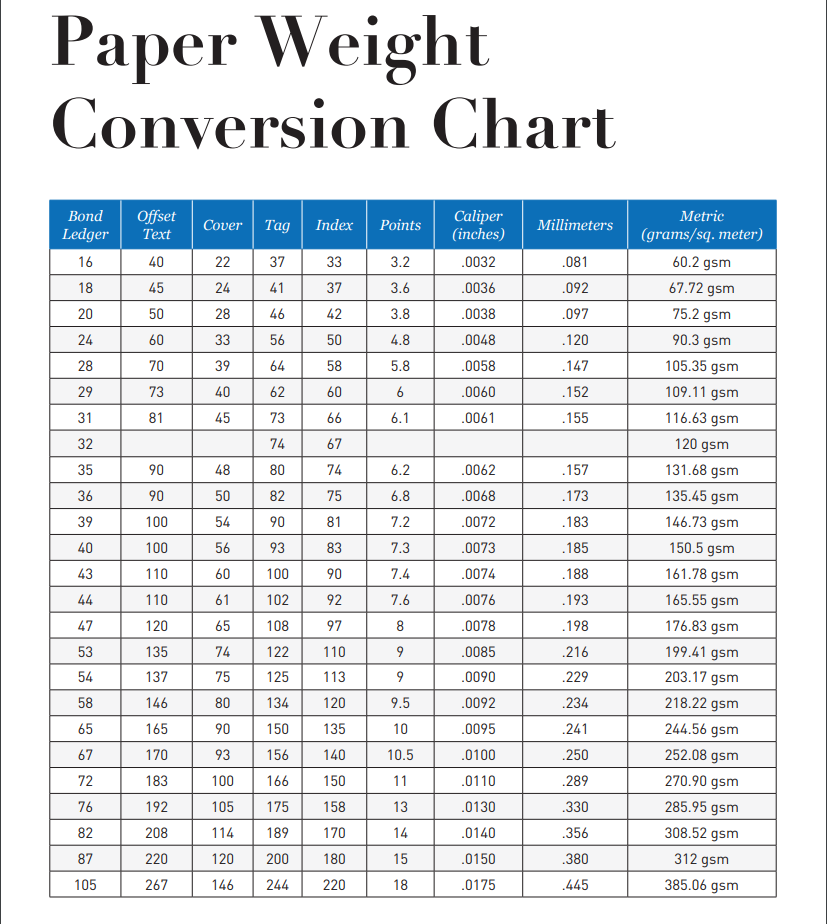
Factors That Affect Paper Weight and Thickness
Paper weight and thickness are influenced by several key factors, including density, fiber composition, coatings, and the calendering process. While many assume that heavier paper is always thicker, this is not necessarily true. The way paper is made and processed significantly impacts its feel, durability, and application.
Density and Fiber Composition
Paper density varies significantly based on:
Raw materials: Premium papers using higher-quality fibers often have greater density
Manufacturing techniques: Advanced production methods can create denser paper
Additives and fillers: The presence of fillers, sizing agents, and other additives affects weight
This explains why two papers with identical GSM ratings can feel dramatically different. For example, a high-quality 100 GSM cotton paper will typically feel thinner yet more substantial than a 100 GSM paper made from mechanical pulp.
Coated vs. Uncoated Paper
Coatings add weight to paper while affecting its thickness in various ways:
| Coating Type | Weight Added | Effect on Thickness | Common Uses |
| Gloss | Significant | Minimal increase | Magazines, catalogs |
| Silk/Matte | Moderate | Slight increase | Brochures, premium flyers |
| UV Coating | Minimal | Minimal increase | Book covers, postcards |
| Uncoated | None | Natural thickness | Stationery, books |
Coatings not only change the paper's weight-to-thickness ratio but also affect how it handles ink, moisture, and folding.
Calendering Process
Calendering is a critical manufacturing process where paper passes through a series of heavy rollers that compress and smooth the surface. This process:
Reduces thickness without significantly changing weight
Increases smoothness by compressing surface fibers
Creates density variations within the same paper type
Determines finish quality (higher calendering = smoother finish)
The degree of calendering can make two papers with identical weight feel substantially different in thickness and rigidity. Highly calendered papers appear thinner and denser, while less calendered papers maintain more of their natural bulk and texture.
How to Measure Paper Weight Yourself
If you need to determine the weight of a paper sample, you can do so with simple tools and a few calculations. Measuring paper weight manually is useful when labels are missing or when comparing different paper types. Below, we outline the tools required, step-by-step instructions for measuring GSM, and how to check thickness with a caliper.
Tools Needed
To accurately measure paper weight and thickness, you'll need these basic tools:
Paper sampler cutter: A specialized tool that cuts precise 100 cm² samples
Digital scale: Must be accurate to at least 0.01 grams for precision
Caliper or micrometer: For measuring paper thickness in points (1/1000 inch)
Calculator: For simple conversions and calculations
Most printing companies have these tools, but affordable versions are available for small businesses and serious crafters.
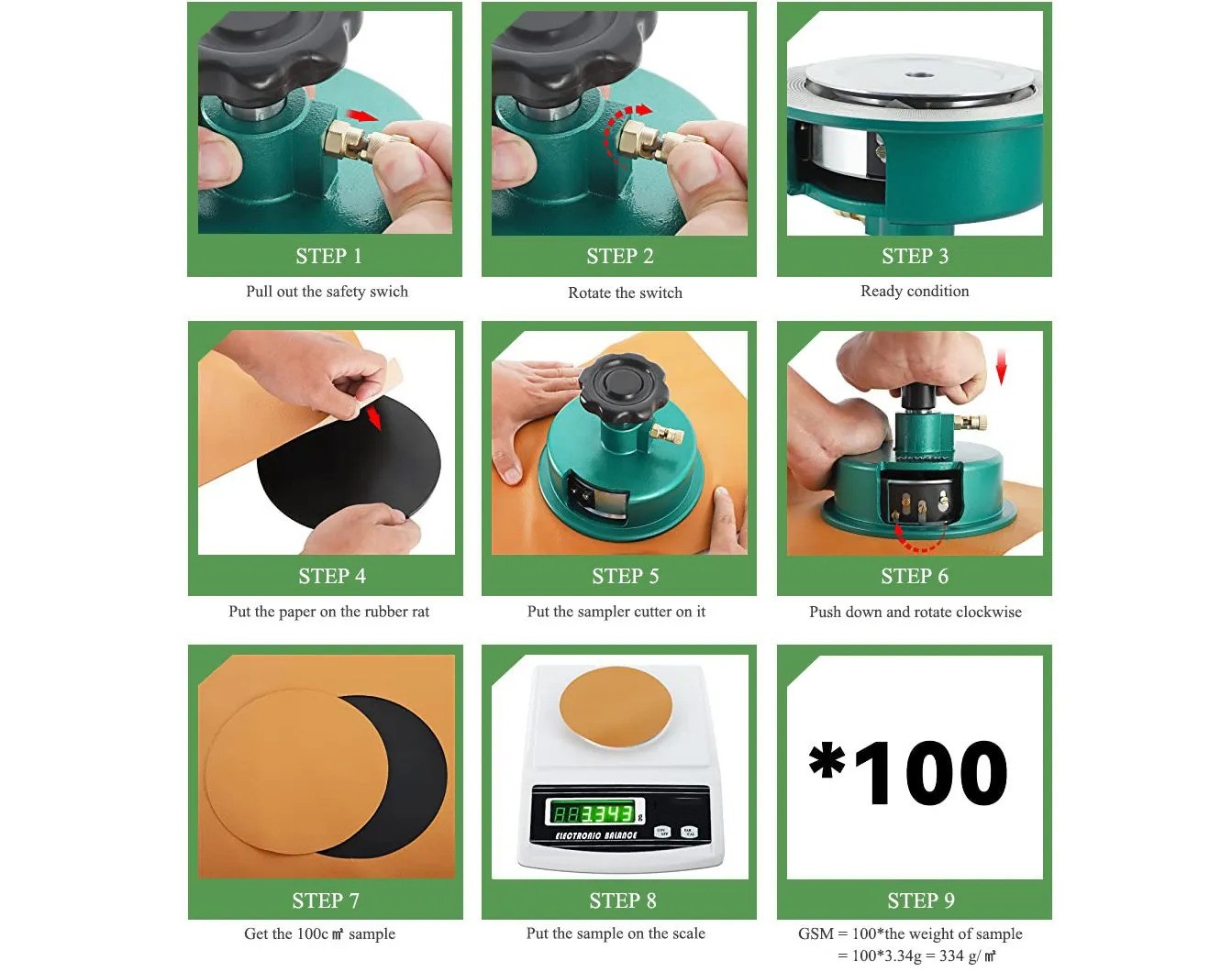
Step-by-Step Guide to Measuring GSM
GSM (grams per square meter) is the most universal paper weight measurement. Here's how to determine it:
Prepare your sample cutter by pulling out the safety switch and rotating to ready position
Place paper on the rubber mat of the cutter
Position the cutter over the paper
Push down and rotate clockwise to cut a precise 100 cm² sample
Place the sample on your digital scale and note the weight in grams
Multiply the weight by 100 to calculate GSM
This method works because 100 cm² is exactly 1/100th of a square meter, making the conversion straightforward.
Checking Thickness with a Caliper
To measure paper thickness in points:
Calibrate your micrometer to zero
Place a single sheet between the measuring surfaces
Gently close the micrometer until it touches both sides without compressing the paper
Read the measurement in inches and multiply by 1000 to get points
| Measured Thickness | Common Applications |
| 7-9 points | Brochures, postcards |
| 10-12 points | Business cards, book covers |
| 14-16 points | Premium business cards, packaging |
| 24+ points | Hang tags, rigid packaging |
For consistent results, take multiple measurements from different areas of your paper sheet and calculate the average.
Choosing the Right Paper Weight for Your Needs
Selecting the appropriate paper weight is crucial for your project's success, affecting everything from print quality to postage costs.
How Paper Weight Affects Print Quality
Paper weight significantly impacts how ink interacts with the paper:
Lightweight papers (under 80 GSM/20# bond) often allow ink to show through to the reverse side (bleed-through)
Heavier papers absorb ink better, producing more vibrant colors and sharper images
Paper thickness affects how a printed piece feels in hand, influencing perceived quality
Improper weight selection can cause warping, curling, or jamming in printing equipment
For double-sided printing, select paper that's heavy enough to prevent show-through but not so heavy it creates feeding issues in your printer.
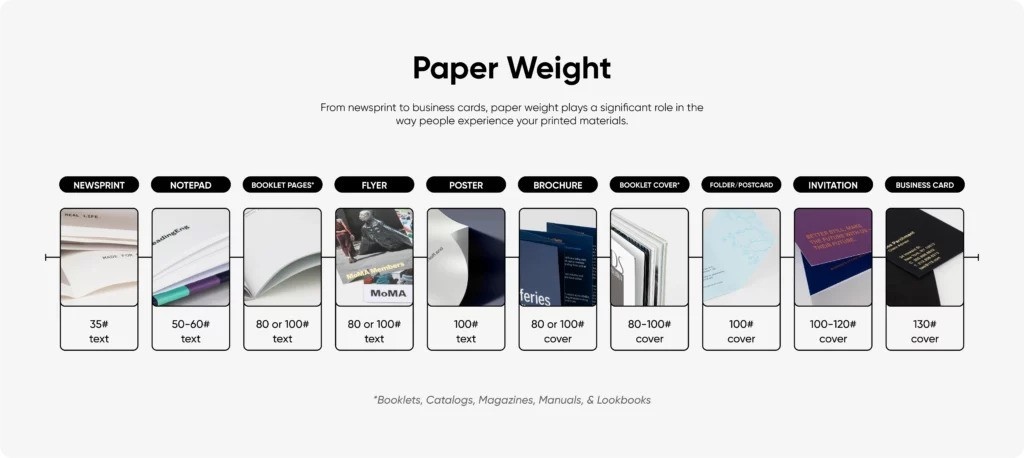
Paper Weight Recommendations for Different Uses
Different projects require specific paper weights for optimal results:
| Paper Type | Weight Range | Best Uses | Characteristics |
| Lightweight | 35-80# text
(50-120 GSM) | Newspapers, workbooks, flyers, inserts | Easily foldable, economical for mass distribution |
| Mid-weight | 80-100# text
(120-148 GSM) | Magazines, booklets, brochures, posters | Good balance of quality and cost, handles color well |
| Heavyweight | 80-130# cover
(216-350 GSM) | Business cards, postcards, invitations, folders | Substantial feel, premium impression, durable |
For multi-page documents, consider using different weights—heavier stock for covers and lighter for interior pages.
Paper Weight and Mailing Regulations
Postal regulations place specific requirements on paper thickness:
For mass mailings, paper weight directly affects postage costs. Consider these strategies:
Use the minimum acceptable weight that maintains quality
Choose lighter papers for high-volume mailings
Consider uncoated stock (often lighter than coated equivalents)
Test samples before committing to large print runs
Conclusion
Understanding how paper weight is measured helps you choose the best paper for your needs. GSM, pounds, points, and caliper thickness are the most common measurement systems.
Selecting the right paper weight ensures better print quality, durability, and cost efficiency. Lightweight paper works for flyers, while thicker stock suits business cards and invitations.
Always consider print compatibility and mailing costs before choosing a paper weight. A well-informed choice enhances professional results and reduces unnecessary expenses.
FAQs
Q: What does 100 lb paper weight mean?
A: 100 lb paper weight refers to the basis weight, meaning 500 uncut sheets of that paper type weigh 100 pounds. However, the thickness and feel of 100 lb text paper differ from 100 lb cover stock due to different basis sheet sizes.
Q: How thick is 250gsm paper?
A: 250 GSM paper is typically around 10-12 points (pt) or 200-250 microns thick. The exact thickness depends on the paper composition and coating, as coated paper tends to be thinner than uncoated paper of the same GSM.
Q: How to identify a paper weight?
A: You can identify paper weight using GSM (grams per square meter), basis weight (lb), or caliper thickness (pt). Measure a 100 cm² sample, weigh it, and multiply by 100 to determine GSM. For thickness, use a caliper to check the point size.
Q: How is paper weight calculated?
A: Paper weight is calculated based on GSM, basis weight, or thickness. To find GSM, weigh a 100 cm² paper sample and multiply by 100. Basis weight is measured by weighing 500 uncut sheets in pounds, while calipers measure thickness in points (1 pt = 0.001 inches).
Q: Is 120 GSM paper good?
A: Yes, 120 GSM paper is excellent for high-quality printing, brochures, and premium stationery. It is thicker than standard printer paper (80-100 GSM) and prevents ink bleed-through while maintaining flexibility for folding.
Q: What is the difference between text and cover paper weights?
A: Text paper is lighter and used for flyers, booklets, and brochures (50-100 lb). Cover paper is heavier, thicker, and used for business cards, invitations, and postcards (80-130 lb). A 100 lb text paper is much thinner than 100 lb cover stock.
Q: Is a higher paper weight always better quality?
A: Not necessarily. Higher weight paper is thicker and more durable, but coatings, fiber quality, and density also impact quality. Some lightweight, high-density papers offer superior performance compared to heavier, lower-quality paper.






























